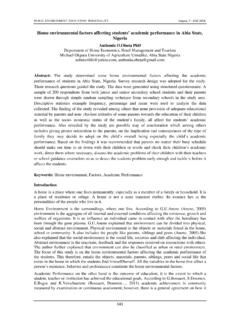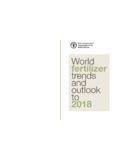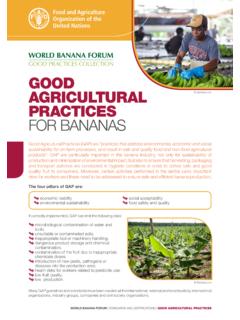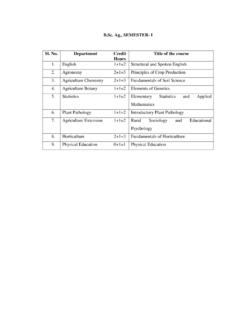Transcription of FINANCIAL AND NON-FINANCIAL FACTORS …
1 Proceedings of the 2017 International Conference economic SCIENCE FOR RURAL DEVELOPMENT No 46 Jelgava, LLU ESAF, 27-28 April 2017, pp. 345-350 1 Corresponding author. Tel.: + 371 26540054 E-mail address: 345 FINANCIAL AND NON- FINANCIAL FACTORS AFFECTING SOLVENCY: A THEORY REVIEW Inese Rozenbaha1, , PhD student Faculty of Business, Management and Economics, University of Latvia Abstract. Researchers have developed various models for predicting insolvency as well as analysed dozens of various FINANCIAL ratios; however, a universal model and set of ratios have not been found. Each country has its own tax policy and national economic indicators that influence the respective business environment. Besides, such FACTORS as business managers competence and appropriate adoption of decisions can also influence sustainable operation of businesses.
2 In the review of scientific literature on the development of models for forecasting insolvency, the author has created her own theoretical model based on the analysis of FINANCIAL and non- FINANCIAL FACTORS . The aim of the research is to analyse the FINANCIAL and non- FINANCIAL FACTORS mentioned in the research and choose the ones that will be used in further research about Latvian agriculture companies with regard to the available data. The literature review shows that research defines 4 directions of finance that analyse liquidity, turnover, profit and liabilities based on the data from balance sheets and profit and loss accounts. It is more complicated to establish the non- FINANCIAL FACTORS due to the unavailability of information; however, it is still possible to analyse such FACTORS as company s age, size and payment behaviour.
3 The author also mentions tax liabilities as an additional non- FINANCIAL factor that should be analysed in further research. Key words: FINANCIAL FACTORS , cash flow, non- FINANCIAL FACTORS , solvency. JEL code: G20, G30, G33 Introduction Insolvency of company has been studied since 1960s. The term insolvency describes the FINANCIAL situation of a company when it is capable of a sufficiently successful performance for meeting all its liabilities (Sneidere R., 2009). Companies, to provide for their sustainability, perform operational FINANCIAL analysis that deliver timely warning about solvency problems and possible risks by mainly analysing the company s liquidity, its creditability and FINANCIAL stability. As to 9 January 2017, in Latvia 12 insolvency cases have been filed for legal entities.
4 In 2016, there were 656 such cases, in 2015 802 cases and 960 cases in 2014 (Lursoft data base, 2017). The figures suggest a positive trend decreasing in the number of cases, which means that companies have to assess their solvency to prevent the filing of such cases. The assessment would in due time inform about problems and enable companies prevent company s failure. Research has been conducted in various fields to adjust the insolvency prediction models to the businesses of various shapes and sizes ( joint-stock companies, private companies). The Author focuses on agriculture as an industry that has been of historic importance to Latvia. The development of agriculture companies and their ability to survive under changing economic conditions depend on various FACTORS both on the national agriculture development guidelines as well as global trends in the demand for agriculture products and such FINANCIAL FACTORS as the availability of credit resources and stability of cash flow.
5 There have been innumerable studies regarding predicting the solvency of businesses and FINANCIAL indicators to be used in the process. (Beaver , 1966; Altman , 1968, 2005, 2006, 2010; Ooghe H., 2008; Sneidere R., 2009). In their calculations, researchers use both FINANCIAL and non- FINANCIAL FACTORS that allow for early identification of solvency issues. In studies, more attention is paid to the FINANCIAL ratios calculated based on FINANCIAL reports rather than non- FINANCIAL FACTORS , such as management skills or company age. The research object is FINANCIAL and non- FINANCIAL FACTORS affecting solvency. The aim of the paper is, based on the analysis of the FINANCIAL and non- FINANCIAL FACTORS for solvency prediction examined in scientific literature, to define the FACTORS by which the Proceedings of the 2017 International Conference economic SCIENCE FOR RURAL DEVELOPMENT No 46 Jelgava, LLU ESAF, 27-28 April 2017, pp.
6 345-350 1 Corresponding author. Tel.: + 371 26540054 E-mail address: 346 author will further perform the FINANCIAL analysis of Latvian agriculture businesses. The aim implies the following tasks: 1) to analyse and assess the theoretical basis provided by scientific literature regarding the FACTORS influencing solvency; 2) to consolidate the data of previous research on the significance of FACTORS ; 3) to define the facts the calculation of which would allow to the prediction of solvency in Latvian agriculture enterprises. Research results and discussion 1. Review of literature on FINANCIAL indicators In literature, the models for forecasting solvency are mainly based on the analysis of FINANCIAL ratios. One of the first researchers addressing the issue in 1968 was Altman who in his paper FINANCIAL Ratios, Discriminant Analysis and the Prediction of Corporate Bankruptcy introduced the Z-Score model, based on 5 variables calculated based on the company s balance sheet and income statement data: working capital and total assets, retained earnings, earnings before interest and taxes, market value of equity, total liabilities and sales (Altman , 1968).
7 According to this model, the minimum result suggesting the possibility of avoiding failure is ; however, for a company to be in a safe zone, the result has to be from upwards. In further research, Altman enlarged the number of the indicators to be considered. He divided the ratios in 5 accounting ratio categories: leverage, liquidity, profitability, coverage and activity, which are calculated based on 10 FINANCIAL ratios, thus increasing the number of the significant FINANCIAL ratios defined by him as follows: short term debt/equity, liabilities/total assets, cash/total assets, working capital/total assets, EBITDA (earnings before interest, taxes, depreciation and amortization)/total assets, retained earnings/total assets, EBITDA/interest expenses, EBIT (earnings before interest and taxes), sales/total assets, account receivable/liabilities (Altman , 2010).
8 However, in the study FINANCIAL and non- FINANCIAL variables as long-horizon predictors of bankruptcy (2015), there are the following 8 efficient solvency problem predictors highlighted: total assets, equity ratio, growth in total assets, return on assets ratio, cash and other liquid assets to short-term debt, short term debt to total assets ratio, change in short-term debt to total assets ratio, cash flows to total assets ratio (2015). This research features cash flow ratio analysis the author believes to be very significant because the presence of profit in business does not necessarily indicate the sufficiency of FINANCIAL resources. In agriculture, cash flow sometimes plays the decisive role as the business may be affected by its seasonality. Consequently, in her further research the author will pay attention not only to equity, liquidity and profitability ratios but also cash flow ratios.
9 Beaver W. is to be mentioned as the second among the scholars laying foundations to the analysis of FINANCIAL ratios by testing 30 ratios in his research FINANCIAL Ratios As Predictors of Failure (1966) where the ratios were split into 6 groups. A ratio was chosen from each of the groups the changes of which indicate the possible presence of solvency problems: cash flow/total debt, net income/total assets, total debt/total assets, working capital/total assets, current ratio, and no credit interval. In this research, cash flow is analysed in relation with other ratios being similar to the ones defined by Altman Low cash flow, increase of expenses, weak profitability, low FINANCIAL independence (equity/total balance) are the first indicators of possible solvency problems according to Ooghe H.
10 (2008). The author believes that the increase of expenses at a constant turnover may serve as an indicator of FINANCIAL problems and lack of professional competence in adopting decisions arising from non- FINANCIAL FACTORS (management competence). Linag D. (2016) in his research FINANCIAL ratios and corporate governance indicators in bankruptcy prediction: a comprehensive study Proceedings of the 2017 International Conference economic SCIENCE FOR RURAL DEVELOPMENT No 46 Jelgava, LLU ESAF, 27-28 April 2017, pp. 345-350 1 Corresponding author. Tel.: + 371 26540054 E-mail address: 347 has conducted a significant in-depth survey and has selected 95 ratios and split them into the following categories: solvency, capital structure ratios, profitability, turnover ratios, cash flow ratios, growth, where solvency and profitability ratios are pointed out as the most significant indicators in predicting solvency which has also been suggested by researchers before this survey.









